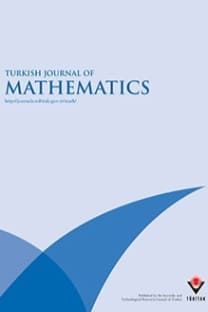A reduced computational matrix approach with convergence estimation for solving model differential equations involving specific nonlinearities of quartic type
Matrix method, error estimation, Mott polynomial, oscillation nonlinearity,
___
- [1] Barker GA Jr. Essentials of Padé Approximants. San Diego, CA, USA: Academic Press, 1975. 237
- [2] Baxley JV, Gu Y. Nonlinear boundary value problems for shallow membrane caps. Communications in Applied Analysis 1999; 3: 327-344.
- [3] Bisshopp KE, Drucker DC. Large defections of cantilever beams. Quarterly of Applied Mathematics 1954; 3: 272- 275.
- [4] Bülbül B, Sezer M. Numerical solution of Duffing equation by using an improved Taylor matrix method. Journal of Applied Mathematics 2013: 2013; 691614. doi: 10.1155/2013/691614
- [5] Bülbül B, Sezer M. A numerical approach for solving generalized Abel-type nonlinear differential equations. Applied Mathematics and Computation 2015; 262: 169-177.
- [6] Chandrasekhar S. Introduction to the Study of Stellar Structure. New York, NY, USA: Dover, 1967.
- [7] Dickey RW, Rotationally symmetric solutions for shallow membrane caps. Quarterly of Applied Mathematics 1989; 47 (3): 571-581.
- [8] Duan JS, Rach R. A new modification of the Adomian decomposition method for solving boundary value problems for higher order nonlinear differential equations. Applied Mathematics and Computation 2011; 218: 4090-4118.
- [9] Duggan R, Goodman A. Pointwise bounds for a nonlinear heat conduction model of the human head. Bulletin of Mathematical Biology 1986; 48 (2): 229-236.
- [10] Erdèlyi A, Magnus W, Oberhettinger F, Tricomi FG. Higher Transcendental Functions. Vol. III. New York, NY, USA: McGraw-Hill Book Company, 1955.
- [11] Giné J, Valls C. On the dynamics of the Rayleigh–Duffing oscillator. Nonlinear Analysis Real World Applications 2019; 45: 309-319.
- [12] Gümgüm S, Savaşaneril NB, Kürkçü ÖK, Sezer M. A numerical technique based on Lucas polynomials together with standard and Chebyshev-Lobatto collocation points for solving functional integro-differential equations involving variable delays. Sakarya University Journal of Science 2018; 22 (6): 1659-1668.
- [13] Haq S, Ishaq M. Solution of strongly nonlinear ordinary differential equations arising in heat transfer with optimal homotopy asymptotic method. International Journal of Heat and Mass Transfer 2012; 55: 5737-5743.
- [14] He JH. Some asymptotic methods for strongly nonlinear equations. International Journal of Modern Physics B 2006; 20 (10): 1141-1199.
- [15] Kanth ASVR, Aruna K. He’s variational iteration method for treating nonlinear singular boundary value problems. Computers & Mathematics with Applications 2010; 60: 821-829.
- [16] Kruchinin DV. Explicit formula for generalized Mott polynomials. Advanced Studies in Contemporary Mathematics 2014; 24 (3): 327-322.
- [17] Kürkçü ÖK. A new numerical method for solving delay integral equations with variable bounds by using generalized Mott polynomials. Eskişehir Technical University Journal of Science and Technology A - Applied Sciences and Engineering 2018; 19 (4): 844-857.
- [18] Kürkçü ÖK, Aslan E, Sezer M. A numerical method for solving some model problems arising in science and convergence analysis based on residual function. Applied Numerical Mathematics 2017; 121: 134-148.
- [19] Liao SJ. An analytic approximate technique for free oscillations of positively damped systems with algebraically decaying amplitude. International Journal of Non-Linear Mechanics 2003; 38: 1173-1183.
- [20] Momani S, Ertürk VS. Solutions of non-linear oscillators by the modified differential transform method. Computers & Mathematics with Applications 2008; 55: 833-842.
- [21] Mott NF. The Polarisation of electrons by double scattering. Proceedings of the Royal Society A 1932; 135: 429-458.
- [22] Na TY. Computational Methods in Engineering Boundary Value Problems. New York, NY, USA: Academic Press, 1979.
- [23] Nayfeh AH. Problems in Perturbation. New York, NY, USA: Wiley, 1985. 238
- 24] Odibat Z, Bataineh AS. An adaptation of homotopy analysis method for reliable treatment of strongly nonlinear problems: construction of homotopy polynomials. Mathematical Methods in the Applied Sciences 2015; 38: 991- 1000.
- [25] Pandey RK, Singh, AK. On the convergence of finite difference method for a class of singular boundary value problems arising in physiology. Journal of Computational and Applied Mathematics 2004; 166: 553-564.
- [26] Rajaraman R, Hariharan G. An efficient wavelet based spectral method to singular boundary value problems. Journal of Mathematical Chemistry 2015; 53: 2095-2113.
- [27] Roman S. The Umbral Calculus, Pure and Applied Mathematics, 111. London, UK: Academic Press, 1984.
- [28] Singh R, Kumar J. An efficient numerical technique for the solution of nonlinear singular boundary value problems. Computer Physics Communications 2014; 185: 1282-1289.
- [29] Solane NJ. The On-Line Encyclopedia of Integer Sequences. Ithaca, NY, USA: OEIS Foundation, 2019.
- [30] Strutt JM. Scientific Papers. London, UK: Macmillan and Co., 1943.
- [31] Sweilam NH, Khader, MM. Exact solutions of some coupled nonlinear partial differential equations using the homotopy perturbation method. Computers & Mathematics with Applications 2009; 58: 2134-2141.
- [32] Wazwaz A. The variational iteration method for solving nonlinear singular boundary value problems arising in various physical models. Communications in Nonlinear Science and Numerical Simulation 2011; 16 (10): 3881-3886.
- ISSN: 1300-0098
- Yayın Aralığı: 6
- Yayıncı: TÜBİTAK
Unimodality and linear recurrences associated with rays in the Delannoy triangle
Said AMROUCHE, Hacène BELBACHIR
Jhon Jairo BRAVO, Maribel DÍAZ, José Luis RAMÍREZ
A Galerkin-like method for solving linear functional differential equations under initial conditions
Şuayip YÜZBAŞI, Murat KARAÇAYIR
Şuayip YÜZBAŞI, Murat KARAÇAYIR
Thanh Hung PHAM, Thanh Tung LE
Said AMROUCHE, Hacène BELBACHIR
